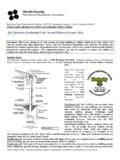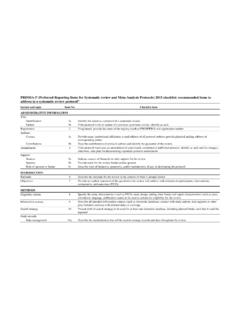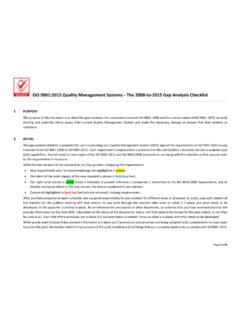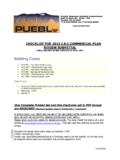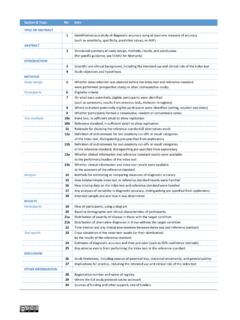Transcription of Footing Inspection Checklist 2015 - HCPD C
1 Hardin County Government Center 150 N. Provident Way, Suite 225 Elizabethtown, Kentucky 42701 270-769-5479 FAX: 270-769-5591 Building Code Clarification Handout, # 2015 , June 2015 Footing Inspection Checklist Page 1 of 2 These requirements are taken from the following adopted codes and ordinances in Hardin County: 2013 Kentucky Residential Code, IRC Code 2012, the Hardin County, KY Development Guidance System, and from the Storm Water Management Ordinances. Refer to these codes if more detailed information is needed.
2 Disclaimer: This is not a listing of all code sections involving building or utilities which involve this subject, but only the sections most often questioned. Refer to the 2013 Kentucky Residential Code book for information not listed in this handout and for other requirements of the building code. At the request of owners and builders, the following is a basic listing of requirements the building inspector looks for at time of Footing Inspection . It is anticipated that owners and builders will use this Checklist to be sure they are ready for the Inspection and prior to calling to request the Footing Inspection .
3 1. Building permit has been applied for and obtained. Permit fees have been paid. ( ) 2. Building permit has been posted on project site and is visible from street. The building permit or copy thereof shall be kept on the site of the work until the completion of the project. ( ). Building drawings are on-site and available to the workers. Access to the site is to be furnished by Owner. 3. The lot number or street number has been posted on site visible from the street using 4 high numbers or larger.
4 ( ). 4. The new construction project (house, addition, garage, pool, shed, etc.) has been measured exactly and located on the property by a licensed surveyor or other responsible trained person to assure it is in the same location described on the approved permit application, and is not in conflict with the property line building setbacks; the drainage and utility easements of recorded subdivision plats; the private subdivision restrictions established by the developer.
5 And not in conflict with the Development Standards, Residential Districts. ( ) 5. The requirements of the Storm water Runoff Ordinances have been installed to prevent erosion onto neighboring properties, adjacent streams and ditches, and onto streets adjacent to the property, before disturbance of the site begins. [Kentucky Erosion Prevention & Sediment Control Field Guide] Specifically the following (where appropriate) Storm Water Runoff Ordinance requirements will be expected: A.
6 The construction entrance (driveway) has been installed a minimum of 20 feet wide by 50 feet long. The end of the entrance where it meets the main road shall be flared. B. A temporary culvert or driveway tile has been installed. C. Gravel used in construction of the pad is large enough that vehicles do not carry it off. #2 size rock or #3 rock is typically used. At least 6 inches thickness of gravel should be installed for the entire length and width of the construction entrance.
7 Gravel material is being added where surface voids are visible. D. Areas downhill of the building footprint that are likely to receive erosion and water runoff have been protected with properly installed sediment traps, silt fences, vegetation buffers, and silt check dams of rock or other approved products. Silt fences should be installed on the ground contour below bare soil areas. E. Seeding or mulching of all bare soil areas that are not being worked after 21 consecutive days has been established.
8 F. Mulch or grass is established on bare areas that are at final grade. 6. The bottom of the Footing is dug at 24 inches below finished grade minimum. Where backfill is to be added to obtain the 24 inch depth, the Footing has been dug a minimum of 12 inches into solid subgrade soil. ( ). The minimum frost depth shall be measured from the proposed finish grade to the bottom of the Footing . 7. All loose dirt fill and debris has been removed from the interior of the Footing . Compacted Footing soil is free of vegetation, roots and branches.
9 The Footing is clear of water. ( Amendments) 8. The Footing is not bearing on frozen soil. ( Frost Protection). The width of the Footing is no less than 12 inches (if one-story) and no less than 16 inches (if two-story) and as established by Table and Figure (1). Spread footings Building Code Clarification Handout, # 2015 , June 2015 Footing Inspection Checklist Page 2 of 2 shall be at least 6 inches thick. Footing projections shall be at least 2 inches past all sides of the foundation wall and shall not exceed the thickness of the 9.
10 The top surface of the footings is level. The bottom surface of the footings shall not have a slope exceeding one unit vertical in 10 units horizontal (10 percent slope). footings shall be stepped when the slope exceeds one unit vertical in 10 units horizontal. ( ) 10. All footings shall be supported on undisturbed natural soils or engineered fill. ( ) 11. Rebar in Footing (Optional in Seismic Design Category, B , Hardin County), ( ) At least two runs of dia.

